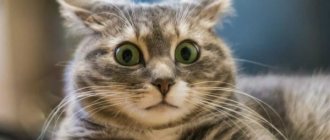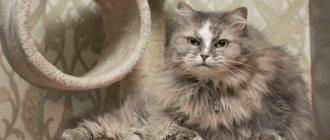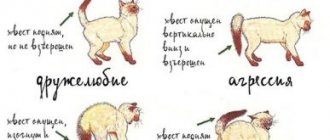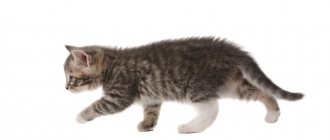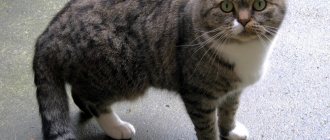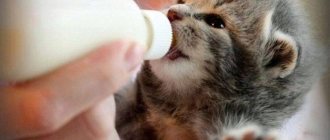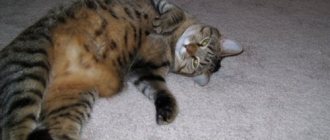Deficiency and consequences
At each stage of life, a cat should receive the required amount of calcium appropriate to its age and needs. Without calcium, processes such as the transmission of nerve impulses and muscle contraction are not possible.
Proper calcium intake – in the right amount and at the optimal period. If a cat lacks a microelement, this immediately affects its health, and the consequences are different at each age. For example, if a kitten lacks calcium, then the situation is aggravated by pathologies in skeletal development. Lack of calcium in a cat in adulthood and old age leads to brittle bones - the possibility of fractures increases. Adult pets feel a lack of this element in the fifth month - that is, five months after the body experiences a shortage. In kittens this happens much faster.
It also happens that a cat has high calcium - what to do in this case? Of course, stop giving your cat calcium. It should be remembered that pets at different periods of life require an increased rate of this microelement - especially at a young age, during lactation. Excessive calcium content in a cat’s body is fraught with bone pathology and osteochondrosis.
It is important to adhere to the consumption norm. Is your cat lacking calcium? Use an approximate calculation of consumption - only a veterinarian will provide more accurate information.
- kittens - 440 mg per 1 kg of weight ;
— adult cats – 45 mg per 1 kg of weight .
For example, an adult cat weighing 4 kg should receive 180 mg of calcium per day .
eclampsia in a cat
It is necessary to closely monitor the new mother, since pregnancy could lead to a dangerous disease called eclampsia. A cat that has just given birth has no chance of coping with the disease without your help. A cat with a large litter needs additional (forced) milk feeding. 3 weeks is a must. Total daily volume = 60-90 ml. Inappropriate anxious behavior occurs due to low levels of calcium in the blood. Pregnancy, childbirth and lactation - how much calcium do you think you need? A cat can lightly bite and press the squeaking kittens with her paw, but she does not hurt them and they immediately calm down. Careless dragging and wanton biting should always be a concern.
what is eclampsia? This is an acute nervous disorder that occurs in animals that have recently given birth and are lactating. Eclampsia in cats after birth is most often caused by a lack of calcium in the body. This leads to metabolic disorders, which leads to seizures and often the death of the pet. Clinical signs of the disease are similar to those of epilepsy. Most often, this pathology occurs in young cats in the first week after the birth of their offspring. In addition, the disease can occur due to teething, poor nutrition, and infectious diseases. Whatever the causes of the pathology, it is necessary to begin treatment immediately. causes of eclampsia in cats Postpartum eclampsia in cats occurs most often for three reasons. This may be a genetic predisposition, impaired metabolism or external causes. The latter refers to too frequent births, mastitis, a large number of babies in one litter, and lack of nutrients. symptoms of eclampsia in cats A characteristic sign is restlessness, dilated pupils, obsessive meowing and anxiety. Not necessarily one of the most striking symptoms is dog breathing or stretching of the face. Calcium deficiency accumulates and you can then get all of the above + cannibalism. Such cases have been described. This is a disease, not inappropriate behavior. In cats, symptoms of this disease may include the following:
- pet behaves inappropriately
- she looks like she's lost
- mastitis appeared
- The cat's mood changes dramatically from horror to happiness
- temperature reduced
- coordination is impaired
- dilated pupils
- convulsions
- 1 ml calcium borogluconate
- 2 ml saline or glucose 5% (!!! Not Ringer)
- 1 ml Traumatin
- 1 ml Gamavit or Gamavit Forte (!!!be sure to take it last) The therapeutic dose after relieving an attack of eclampsia should be given for a week, twice a day. And then for another ten days, a prophylactic dose of 1.5 ml once a day. You just need to inject it correctly. Here errors and negligence can come out sideways. If the cat is still bleeding after giving birth, then it is only gamavit, and not gamavit forte. Do 1 r per day, in severe cases 2 r. in a day. We do this until the signs of eclampsia go away + another 2-3 days. Inject Gamavit and inject calcium gluconate for up to 7 days and in a higher dose for signs of eclampsia - 1.5 cc in each leg, intramuscularly, every hour until these same signs disappear .. then twice a week for prevention. You can take calcium gluconate for injection, 2 cubes every 2 hours. Of course, the effect is more noticeable with injections. 2 cubes at least 4-5 times, every 2 hours.
- Tobrex for cats Instructions for useTobrex drops contain a broad-spectrum antibiotic - tobramycin from the group...
- Amlodipine for cats Instructions for use of Amlodipine: in medicine and veterinary medicine VetConsultPlus Information portal Therapy Brief characteristics…
- Cutaneous horn General description of the disease Cutaneous horn on the forehead or face (ICD 10 code - L57.0) -...
- Fosprenil for cats Instructions for use Fosprenil is administered to a cat intravenously, intramuscularly or subcutaneously. If necessary, an injection is allowed in…
Approximately 8-12 hours after the first signs of the disease appear, the muscles lose their elasticity and become stiff. For this reason, the cat can take strange poses, bend, trying to eliminate this inconvenience.
Treatment of eclampsia in cats Treatment should be started immediately. It consists in saturating the body with calcium. The cat began to get nervous... Nervously licks itself and the child, rushes around the cage. Place 1 cube of calcium gluconate (total 2) warmed up in different paws, inject slowly, does it look like the pupils are dilated? In any case, it is better to give it, even if this is a reaction to your excessive manipulations with the kitten. If the condition does not improve, repeat the injection after about an hour. The therapeutic dosage of calcium gluconate is 2.5 ml. every 40 minutes. No more than 10 ml. per day. Inject - and see if the symptoms go away - inject again. However, if it immediately becomes easier, then this is even more so - eclampsia. You relieve the acute condition, then switch to preventive dosages. Calcium gluconate is injected warmed up to body temperature and deep into the muscle. Inject into the rear leg, the needle is not perpendicular to the bone, but at an angle of approximately 45 degrees. Borgluconate can be applied to the withers - this is a veterinary drug. If you have calcium gluconate, then it is ONLY in the muscle. Don't be afraid, it's actually not scary, the main thing is to think about how to fix your leg while you prick. It must be introduced slowly. Colite calcium. Don't wait until it drags. A 2 cc syringe is better, if the midge is small, insert the needle 1/2 full. Borgluconate is injected subcutaneously. Calcium gluconate intramuscularly. It’s easier to buy veterinary calcium borogluconate and administer it subcutaneously. It is not so painful, and subcutaneous injections are easier to do. Better yet, inject the cat with a cocktail, done subcutaneously. Draw the drugs into the syringe strictly in the specified sequence:
Useful materials:
Sources of calcium for cats
If pets are naturally fed, it is important for the owner to consider where they will get calcium from. As for meat, this is a controversial source of calcium, because most of the phosphorus enters the body with it - but the cat receives very little calcium from meat. It is important to consider the ratio of phosphorus and calcium in the diet. The norm for adults is 1:1.2 or 1:1 . For kittens – 1:1.4 . To the question “ can cats have calcium? ” there is only one answer – it is necessary , and regularly . If, when fed with balanced food, the cat receives its daily requirement - calcium in cat food is necessarily taken into account, then with a natural type of nutrition, all responsibility falls on the shoulders of the owner - it is he who chooses the source of calcium for the pet.
It should also be noted that calcium is not absorbed by cats from foods of plant origin - we have to look for alternative options.
Eggshell: calcium carbonate
Of the natural sources of calcium, eggshells immediately come to mind. Indeed, it consists of 36% calcium. One quail egg shell weighs approximately 1.5 grams. The shell contains calcium carbonate - not the best compound, because... Only 20% is absorbed.
To calculate how many shells a cat needs per day, the daily meat consumption is taken into account. Let's say a cat eats 200g of meat per day, which corresponds to about 400-500mg of phosphorus and about 50mg of calcium. The amount of phosphorus depends on the type of meat (see table below). Accordingly, such a daily dose should contain at least 450 mg of calcium. It turns out that for every 100 grams of meat you need 1 gram of shell (1 shell). An adult cat, eating 200 grams of food per day, should receive approximately 2 quail egg shells. If there is a slight excess, the body will remove it.
The fact that you add shells to your food does not guarantee that calcium will be absorbed by at least 20%, because... the shell still needs to be crushed, preferably into powder: otherwise, in many cats it comes out in pieces along with the feces (the author of the article saw this with his own eyes).
To increase the amount of calcium absorbed, you cannot pour whole spoonfuls of shells into a plate, because calcium carbonate in large quantities causes side effects: it lowers the acidity of the stomach below normal, causes flatulence, constipation, allergic reactions, and promotes the formation of kidney stones.
Thus, in order to meet your cat’s need for calcium every day throughout his life with the help of shells, you need to count the amount so as not to overdo it too much, but also not to give too little. In addition, due to the low percentage of calcium carbonate absorption, it is advisable to combine the shells with other sources of this mineral. For example, one week a cat may get calcium from the shell, another week from some other source, and so on. Some cats live only on shells without problems - it's better than nothing. However, shells are not an ideal source of calcium for healthy cats.
However, cats with kidney failure who are fed a raw diet are recommended to be fed shells rather than bones. This is due to the balancing of calcium and phosphorus from food. But this is a topic for a completely different conversation. This article is written about healthy cats.
TABLE: phosphorus and calcium per 100 g of product (values in mg)
| PRODUCT | PHOSPHORUS | CALCIUM |
| Hard cheese | 650 | 1000 |
| Eggs (without shell) | 200 | 56 |
| Fish (average) | 300 | 50 |
| Cottage cheese | 150 | 111 |
| Milk | 920 | 1000 |
| Poultry breasts | 310 | 15 |
| Beef liver | 497 | 6 |
| Beef kidneys | 304 | 19 |
| Pork spleen | 283 | 13 |
| Rabbit meat | 263 | 19 |
| Beef heart | 254 | 5 |
| Veal | 250 | 24 |
| horsemeat | 247 | 8 |
| Pork liver | 241 | 10 |
| Pork kidneys | 240 | 13 |
| Beef lean | 237 | 14 |
| Pork fillet | 240 | 22 |
| Venison | 230 | 7 |
| Mutton | 208 | 8 |
| Goat meat | 201 | 17 |
| Pork lung | 186 | 8 |
| Beef lung | 178 | 11 |
| Pig heart | 178 | 7 |
| Pig tongue | 174 | 19 |
| Beef tongue | 145 | 5 |
| Beef tripe | 66 | 81 |
| Pig ears | 24 | 18 |
* The table shows approximate and average data: the content of phosphorus and calcium in certain products varies.
Bones and meat
Meaty bones are a traditional way for cats to obtain calcium. But in this case, you must adhere to certain rules, otherwise you cannot avoid intestinal blockage or other, more serious problems.
However, everyone knows the experience of wild cats - they catch mice and birds, eating them completely - with bones, thereby replenishing the calcium level in the body. Owners feed their tailed pets selectively - mostly boneless meat. So should you give your cat bones?
Bone products are an excellent source of collagen, calcium, chondroitin, and glucosamine.
— Do not give your cat sharp bones, which can injure the intestines and lead to internal bleeding. These are the tubular bones of the wings and legs.
- Cats should not be given medium or large bones - these will get stuck in the esophagus or throat.
- Choose suitable bones with meat from the whole carcass. Alternatively, grind the selected parts in a meat grinder or break into small pieces with a hammer.
— Do not give your cat bones that have undergone heat treatment. When boiling or frying, the chemical composition of the bone changes: protein, vitamins and fat go into the broth, and calcium phosphate loses its digestibility.
Bones with meat
The classic source of calcium for cats, according to the postulates of the natural nutrition system, is bones. But there are rules here. If they are not followed, you can cause the cat to have a blockage in the intestines or even perforation of the walls of the mucous membrane, followed by surgery or death. Unfortunately, even animals that are brought to the operating table in time with such a problem cannot always be saved.
In view of this reason, many owners choose a different path for themselves - not to feed bones at all, in order to reduce the risks to zero. But then you will have to take calcium from other sources. Let us say right away that cats cannot absorb calcium from products of plant origin.
Vitamins with calcium
Veterinary pharmacies offer a large number of calcium preparations for cats. Their selection is carried out in accordance with certain rules:
- do not give drugs “by eye” or for a long time - hypervitaminosis is even worse than a lack of vitamins. Do not ignore the instructions and rules for taking vitamins;
- if the cat eats raw boneless meat, purchase vitamin complexes without phosphorus;
- before constantly taking any drug with calcium, make sure there are no allergic reactions - monitor your pet’s health;
- if the pet is on a special professional food, then it contains all the Vitamins that cats need - taking additional supplements is discussed only with a veterinarian.
Calcium supplements for cats
There are several common calcium compounds found in vitamin and mineral supplements for cats.
Calcium carbonate
This compound is found in egg shells and is also found in chalk and shells. Its digestibility is 20% , in addition, side effects are possible with excessive consumption of the supplement. It is better to exclude calcium carbonate from possible options and not consider this calcium requirement for cats.
Calcium gluconate
This is the most famous compound in Russia, but, unfortunately, only 3% . As a vitamin supplement, it is better for cats to replace calcium gluconate with a more suitable option.
Calcium lactate
This is a good calcium compound for kittens up to three months of age, who are still digesting lactose - unlike adult cats. Lactate is contraindicated for cats older than three months - it causes digestive problems.
Calcium citrate
A suitable compound as a vitamin-mineral complex for cats. Digestibility is 44% . This figure is small, but still higher than in the case of calcium carbonate and calcium gluconate. The advantage of use is the low price and the absence of side effects from taking it even if the dosage is exceeded. In the case of calcium gluconate, it is much more difficult to calculate the dosage for a cat.
For dogs and cats, calcium citrate is an optimal dietary supplement.
Calcium chelate
The leader in the digestibility rating is calcium chelate. It is absorbed by the cat's body by 90-98% . This is facilitated by the presence of calcium molecules together with amino acids. With the previously described compounds, the body needs to do additional work - perform long chains of chemical reactions. The cost of the chelate is high, and it is also more difficult to find such an additive. But it's worth it!
Check the prices for vitamins for cat fur - such complexes should be given to cats in courses or on the recommendation of a veterinarian.
Calcium therapy
When contractions stop, the dosage of calcium Gluconate for cats is 1 ml of a 10% solution, which is injected deeper intramuscularly. While labor continues, up to 3 injections every couple of hours are sufficient. Inject Calcium Gluconate or Cal-Pho-Sol. It is imperative to take into account the fact that a large dose causes cardiac shortness of breath. Therefore, it is advisable to have a veterinarian monitor this process. In addition, he can immediately prescribe and administer vitamin B-complex, which is also necessary for a cat in labor. Calcium gluconate is extremely effective in cases of such problematic labor.
Vitamins for cats with calcium
When it comes to the health and longevity of furry pets, the responsibility falls on the owner - cats and dogs simply have no one else to rely on.
The best vitamins for cats with calcium are natural. Such supplements are balanced in composition and can guarantee good digestibility and effectiveness after a course of administration. In this case, it is completely safe to buy calcium for cats.
| Sea calcium - 1023 rub. | Eggshell powder - RUB 1,259 |
cdVet Fit-Barf Sea Calcium contains one valuable ingredient - limestone from seaweed. This is an excellent option for natural feeding of pets, as it neutralizes excess phosphorus in fresh meat. 100% natural composition guarantees good absorption of the vitamin supplement by cats. We also advise you to familiarize yourself with the prices of vitamins for joints for cats - the calcium content in such preparations is also required.
Fit-Barf Eggshell powder is a natural source of calcium, which fits perfectly into the diet of pets and replenishes the lack of calcium in the body.
| MicroMineral — 1336 rub. | ArthroGreen Classic — 2470 rub. |
Fit-Barf MicroMineral is a mineral feed additive containing seaweed, yeast, malt and grape seed extract. The plant origin of the components is valuable for the body of cats, who receive the supplement daily. They do not overload the detoxification organs - liver and kidneys.
Giving calcium oxalate to a cat is a less attractive idea; vitamins from natural ingredients are another matter.
The importance of calcium for cat health. Calcium deficiency for cats
Thus, this element is of great importance not only for the formation of the animal’s bone tissue (skeleton, teeth, etc.), but also for such significant processes as pregnancy, childbirth and even the process of fertilization.
That is why the proper level of calcium for cats must be carefully maintained, helping to replenish its deficiency by any available methods. There are even cases where calcium gluconate was injected intramuscularly into a cat right during childbirth, since labor was completely absent or was sharply declining. The result of such an emergency measure was the resumption of the birth process with a successful outcome. As for the equally important process of conception, calcium plays an important role in this matter, because the lack of this element instantly affects the quality of sperm, preventing them from breaking through the membrane of the egg. Naturally, everything is not limited to the reproductive area alone, because with calcium deficiency, the normal functioning of the cardiovascular system is impossible, as a result of which all harmful substances settle on the walls of blood vessels, significantly contributing to their weakening.
In addition, calcium is actively involved in the contraction of muscle tissue in cats, which is known to occur everywhere. In order to maintain the required level of this element in the cat’s body, the owner must carefully monitor the diet of his pet. The fact is that the body instantly reacts to the slightest changes in this regard, just beginning to make up for the resulting deficit from its own reserve resources. And as you know, only 1 percent of the total amount of calcium is contained in the free current, while the remaining 99 is applied to the skeleton, teeth and claws.
Therefore, it is not surprising that when the natural balance is disturbed, it is the bone tissue that begins to suffer first. And all because it itself consists of a colloidal mass that looks like jelly, while calcium acts as the cement that holds it together. It is quite natural that its deficiency is fraught with the onset of destructive processes and the lack of timely replenishment of this element can result in the most severe complications. Moreover, we can talk not only about permanent fractures, but also about rapidly developing pathologies of the entire musculoskeletal system with all the ensuing consequences. You can determine the level of calcium in your pet’s body using special tests that can be taken at almost any veterinary clinic.
It is especially important to control its amount during a cat’s pregnancy, since calcium deficiency can have a bad effect not only on childbirth, but also on lactation. So, the most common illness that occurs during this period is eclampsia or, more simply, milk fever
Thus, the first signs of eclampsia are severe irritability of the cat, refusal to eat, lack of care for the offspring, a general increase in body temperature, etc. In such cases, it is also recommended to use calcium gluconate injections for cats, since tablets will not have the same fast-acting effect as injections. Preparations containing calcium intended for oral use (tablets) are recommended to be used before or during pregnancy, not forgetting that they only act in combination with phosphorus. The fact is that an excess amount of the second element leads to calcium being poorly absorbed, so it is extremely important to maintain strictly defined proportions of these two interdependent substances.
Ideally, use a ratio of 1 to 1, although the dose of calcium can be increased to 1.21, especially if the cat is severely deficient or is preparing to become a mother. The same principles should be followed when choosing food for your pet, because a properly formulated diet helps combat the deficiency of this element no worse than even the highest quality medications. For example, every cat needs protein (animal protein), which is known to be found in abundance in meat. However, it should be consumed in moderation, and all because there is much more phosphorus in such ingredients than calcium.
In the same chicken, this ratio is 1 to 13, while in offal this figure rises to 50. That is why it is advisable to exclude from the pet’s diet any food containing liver in excess. Beef is deservedly considered the best option when choosing meat products, since in this meat phosphorus exceeds calcium by 8.5 times. Introducing a large amount of cartilage and small bones, including fish, into the animal’s diet will help regulate this discrepancy. Alternatively, you can temporarily introduce the finest ground meat and bone minced meat into the menu. At the same time, it is extremely important that chicken or beef pulp and bones are used for its preparation, but not tubular ones, since their use is dangerous for the life of the pet.
It is also a mistaken opinion that fermented milk products will help eliminate the deficiency of this important element, because the ratio of calcium and phosphorus in them is 1 to 1.25, or even higher. That is why all veterinarians recommend introducing cottage cheese, kefir and sour cream in measured quantities into the cat’s menu.
Therefore, the only food product that is recommended to be given without restrictions to animals suffering from a lack of calcium in the body is whole milk, but only on the condition that it has not been subjected to pasteurization.
>Organic vitamins Part 3. Which calcium is better? Calcium preparations.
Vitamins with calcium for kittens
Kittens require the most calcium. At a young age, active skeletal growth occurs and teeth are formed, so additional calcium supplementation is especially important.
| Milk replacer for kittens - 1260 rub. | FitCroc Cat with reduced protein content - RUB 1,585 | FitCroc Cat - 1994 RUR |
A good idea is to choose premium cat food, in which the calcium level is precisely known, and how much of this microelement the kitten receives per day. In this case, the purchase of additional calcium supplements is discussed with your veterinarian.
Calcium for pets
Calcium gluconate is very important and is needed by both people and animals. Calcium, which forms the skeleton, thereby protecting internal organs, maintaining weight and correct posture, is the driving force of life. Calcium gluconate is involved in such vital processes as :
- growth and strengthening of bones and teeth;
- cardiac activity;
- metabolism;
- strengthening the nervous system;
- fertilization, pregnancy, childbirth;
- hemorrhage.
The level of calcium in the blood is controlled by the parathyroid glands. When levels are low, these glands begin to produce and release parathyroid hormones into the blood. They, in turn, begin to pull calcium from the bones. Why is calcium gluconate considered a “treasure” of bones? To quickly get calcium into the blood, you should inject your cat with calcium gluconate. The parathyroid glands then slow down and stop producing parathyroid hormones. Finally, this microelement again enters its storage.

